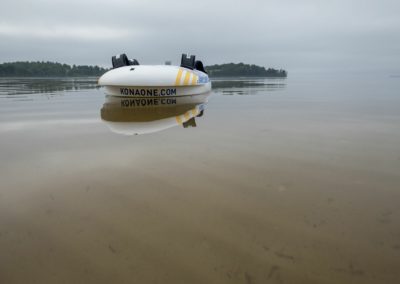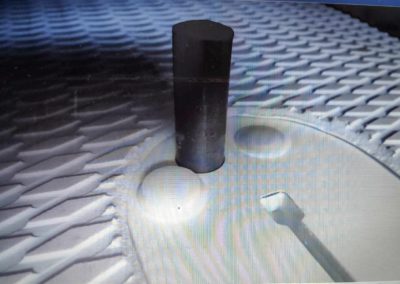
As Kona sailors from around the world are getting ready to celebrate their 14th world championships this summer in Garda, they’ll have something else to celebrate: a redesigned board! It’s exciting, but it begs some explaining as well, because the Kona One class is a one-design class that prides itself on being the fairest racing class around, so mixing boards from different generations is bound to invite scrutiny. As most of you know, Joachim Larsson is the president of Kona Windsurfing AB and the driving force behind the success of the Kona brand over the past decade. He lives on Varamon Beach, in Motala, Sweden, where he’s spent the past few months incubating the development of this exciting new board and putting it to the test. We asked Joachim to give us the lowdown on this new development.
We want people to love their Kona equipment, so when we see a problem, we own up to it and get it fixed!
Joachim LarssonInterview: Kona Club | Photos: Kona Windsurfing AB
Let us ask the tough question first: what’s with a redesigned board? Isn’t the Kona class a one-design class?
JL: Of course it is, and it’s what makes the class such a success. But it’s important to remember that one-design and innovation are not incompatible. Too often in our sport, we let one-design considerations get in the way of implementing healthy changes to our equipment. “It’s one-design so let’s not touch a single thing!” the thinking goes. Of course, we don’t want changes to be so radical that they make older equipment immediately obsolete, but beyond performance, there are many things we can, and should, do on a regular basis: make gear more durable, for instance, or more sustainable, or more fun to sail with. Innovation keeps tradition alive!
So, it doesn’t sail faster?
LOL, no, it doesn’t. We’ve had a chance to use it for a while now here in Sweden, in all sorts of conditions, and even race it alongside the earlier boards at local events. I was on the new board, Björn (Holm) on the old board, and he still beat me by the same margin! (laughs) All the fundamentals are the same with the redesigned board: shape, material, construction, all the appendages are the same. It still glides beautifully in light winds, boosts on a plane early in 10+ kts and screams in 25+ kts. It just looks better doing it!
The cosmetics are quite different.
They are. Still true to our ‘Scandinavian Design’ motto though! We modernized the hibiscus flower a bit along the rails, drew three narrow yellow bands to give more breathing room to the visuals, and you’ll notice that the EVA padding is different too. It covers less surface – it covers all the important foot positions, of course – and if you ever need to replace it, it’s much cheaper and so much less work than the complete deck replacement project we had to do before.
That’s great – but less EVA probably means less weight too?
It does. We’re saving 1.5 kg thanks to this, so the redesigned boards weigh in at 13.5 kg now. We wanted to reduce weight to that the board could be a bit more lively and plane a little earlier when we’re freeriding at home. And at 13.5 kg, it’s easier on lighter sailors too. But to keep things fair for racing, we’ve drilled a couple of tube inserts between the mast track and the daggerboard well, and we’ll use removable lead weights to make up the difference.
What’s the mimimum hull weight for the class?
It’s 15 kg at the moment, so we’ll use this ingenious weight correction system to bring the new boards’ weight up from 13.5 kg to 15 kg. In fact, while this system was developed to equalize the weight of the boards between the two design generations, it’s going to help us reinforce the true one-design quality of the class.
How so?
No manufacturing process is absolutely perfect, and there are always slight variations between things that are supposed to be similar. Olympic sailors spend countless hours testing boards, fins, masts, etc. that are supposed to be identical on paper but end up being off by some small – but critically important – percentage. These manufacturing tolerances are, well, tolerated, but that doesn’t make it any less unfair to athletes who may not have the resources to test everything. On something like the weight of the hull, a manufacturing tolerance of 5% on a 15 kg board means that two identical boards could be off by as much as 750 g – nearly two pounds! With our weight correction system, we can make sure to insert exactly the right amount of lead to hit 15 kg on the dot.
So, the boards will come with inserts that we can take off at home and put back in during racing?
Exactly. Take off the weights, it’s a 13.5 kg easy-to-handle freeride board. Put the weights back in, and it’s a 15 kg legit racing board. It’s a really slick solution. At big events, we’ll ask the class measurer to keep an eye on those weights.
Right, because we don’t want people to take them off while racing!
Absolutely. But you know, Kona racers understand that one of the biggest strengths of the class is how fair it is. And we’re all racing Kona to have fun and make friends, not to chase after better gear than our competitors. No one is going to tamper with those weights.
There were some issues with the daggerboard plates at the worlds in Clearwater last year. Quite a few of them cracked during the event and had to be replaced. Has that been fixed?
Of course! We want people to love their Kona equipment, so when we see a problem, we own up to it and get it fixed. You’ll notice that the fin screw insert on the new board is narrower too, to make it easier to take the fin in and out. And while the nose attachment for your GoPro isn’t new, the leash attachment at the stern is a new addition with this board. Paddleboarding is one of the first things we did with our Konas 14 years ago, and it’s still something we enjoy doing now and then. Now you don’t have to keep the back foot straps on just to attach a leash to them!
Those redesigned boards will be on the course in Garda at the Worlds?
They will! We’ll have a limited supply in Garda, for charters, but we’re excited to introduce them and show them off at the event. We already have orders too from people who saw the new design in Sweden and can’t wait to have two boards in one: a modern Kona One for official racing and a lighter freeride board for everything else. We’re really pleased with the new design and stoked about the future of the class!
Any other exciting things coming up from the Kona R&D department?
Plenty! But that’s for some other time 🙂









My Kona is ready for an update. When will it be possible to buy the new board for US delivery?
I hope Kona will produce a nose guard – even if clip on – for the new model. Launching from a low dock and pivoting the board to carry it on my head have taken a heavy toll on the bow of my current board.
We race Konas on Wednesday nights on Galveston Bay. It has been a very good all around board. The update will make it even better.
Hi Rene, thanks for the feedback and sorry for the late reply! If you check with Sandy Point Progressive Sports in Daytona Beach, they should be able to give you more details about the timing of US delivery for the revised board. Happy racing on Galveston Bay!